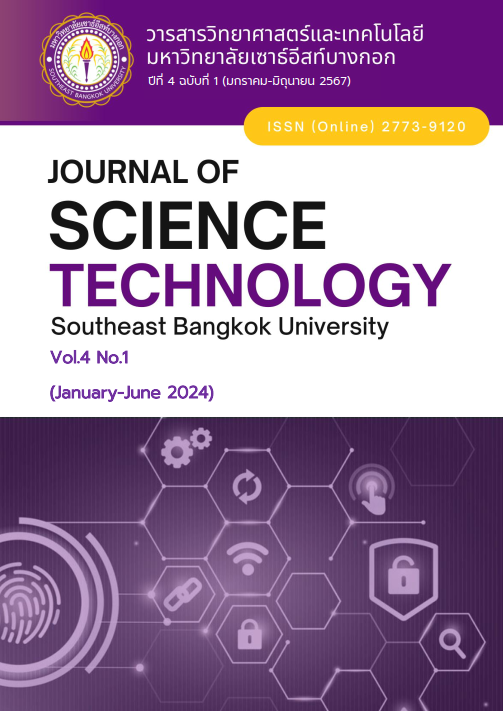APPLICATION OF DMAIC PRINCIPLES BASED ON THE CONCEPT OF SIX SIGMA TO REDUCE DEFECTS IN THE AUTOMOTIVE ASSEMBLY WELDING PROCESS Articles
Main Article Content
Abstract
The purpose of the research was to reduce the waste type of spatter defect in the automotive welding process to not more than 0.2 percent of the volume production per month. The problem is the type of spatter defect. Therefore, waste data was collected for the past 7 months from the total production of 48,260 automobiles. It was found that 490 pieces of waste were in the form of spatter defects, or more than 0.2 percent of the total volume of production per month. Therefore, DMAIC principles are applied as a problem-solving procedure and analysis of root causes with cause-and-effect diagrams. Bring the sub-causes from the analysis to a score level in order of importance. It was found that the sub-cause of scores greater than 80 percent was due to a non-optimal electrical current adjustment. Then, it was chosen to be improved by designing an experiment to find the optimal electrical current value for welding and assembly. The experiment consisted of three related variables: 1) force, 2) time for welding, and 3) welding electrical current value. A 3K factorial experiment was conducted, and the results were analyzed using the Minitab Statistics program. The results of the experiment found that the optimal electrical current value for welding was a pressure value of 3.6 kilonewton/meter, a welding time of 250 millisecond, and a welding current of 7.8 kiloampere, which resulted in the amount of spark generation equal to -0.197, which is a small and optimal amount of spatter. As a result, the average amount of waste before improvement was equal to 0.998 percent per month. After improvement, it decreased to an average of 0.023 percent per month. The Six Sigma level before adjustment was equal to 4.25, and after improvement, it increased to 5.33, indicating the quality level of a better process.
Article Details

This work is licensed under a Creative Commons Attribution-NonCommercial-NoDerivatives 4.0 International License.
This article is published and copyrighted by the Science and Technology Journal. South East Bangkok College
References
Industrial Intelligence Unit: IIU, Economic Office Industry (OIE), “Summary of the Situation of the Modern Automotive Industry Towards the Goal of a Sustainable Economy,” [Online]. Available: https://iiu.oie.go.th/images/document/pdf/20230311135311.pdf. [Accessed: Jan. 08, 2024].
M. Poppendieck, “7 Wastes,” [Online]. Available: http://www.moro.co.th/the-7-wastes. [Accessed: Jan. 08, 2024].
K. Pari, “7 Wastes,” [Online]. Available: https://greedisgoods.com/7-waste. [Accessed: Dec. 18, 2023].
FDI, “7 Wastes,” [Online]. Available: https://fdirecruit.co.th/7-waste. [Accessed: Dec. 03, 2023].
F. W. Breyfogle, Implementing Six Sigma: Smarter Solutions Using Statistical Methods, USA: John Wiley & Sons, 1999.
THANAYUTSITE, “7 QC Tools,” [Online]. Available: https://thanayutsite.wordpress.com/. [Accessed: Oct. 09, 2023].
N. Mahanil et al., “Reducing Waste in the Liquid Detergent Packaging Process by Applying the Six Sigma Concept,” Journal of Science and Technology, Southeast Bangkok University, vol. 3, no. 1, pp. 1-12, 2023.
T. Sriram et al., “Application of the DMAIC Model to Reduce Waste in the Eye Drop Bottle Caps Manufacturing Process,” The 6th National Conference on Informatics, Agriculture, Management, Business Administration, Engineering, Sciences and Technology: IAMBEST 2021, King Mongkut's Institute of Technology Lat Krabang, Chumphon Khet Udomsak Campus, Thailand, pp. 52-60, 2021.
A. Nuprim, “Defect Reduction in a Manufacturing Process; A Case Study in Gloves Manufacturing,” M.Eng. thesis, Department of Industrial Management , Prince of Songkla University, Thailand, 2020.
K. Athikulrat and S. Yindeemorh, “Application of Six Sigma to Reduce Waste from Wire Spokes Production Process: A Case Study on Motorcycle Parts Factory,” KMUTT Research & Development Journal, vol. 43, no. 3, pp. 227-296, 2020.
W. Wannasathit, 7 Quality Control, Business Bulletin Service Co., Ltd., Bangkok, Thailand, 2016.
S. Saiklai, 4M1E Principle, Piyawatana Co., Ltd., Bangkok, Thailand, 2014.
S. Manochai and S. Jongprasithporn, “Productivity Improvement by Design and Analysis of Experiments Case Study: Base of Choke Up,” Graduate Research Conference, Khon Kaen University, pp. 194-202, 2012.
N. Saengsawang and J. Ounwong, “Quality of Resistance Spot Welding Joints of Galvanized Steel With Aluminum 5052 and Stainless Steel 304,” Industrial Engineering Network Academic Conference, Sripatum University, Phetchaburi, Bangkok, pp. 1319-1330, 2012.
M. Magumhin and W. Dokchan, “Reducing of Waste in Filling Processes: A Case Study of Medicinal Products for Human Factory,” Journal of Technical Education Development, vol. 35, no. 124, pp. 63-72, 2022.
W. Kaewyindee et al., “Waste Reduction of Dyeing and Finishing Process by Six Sigma,” Graduate Research Conference, Rangsit University, pp. 2529-2536, 2018.


